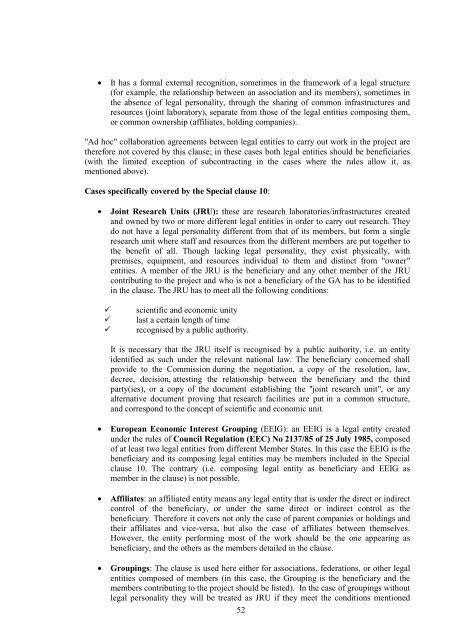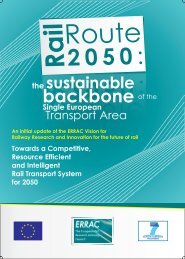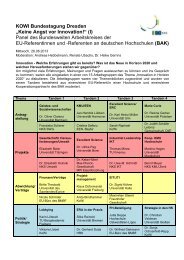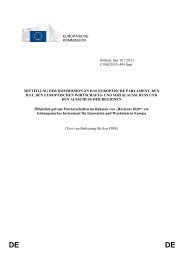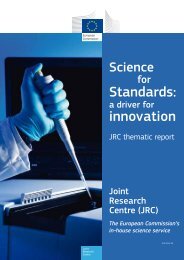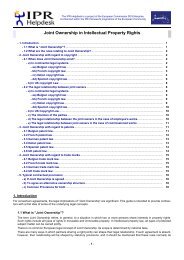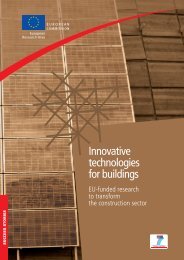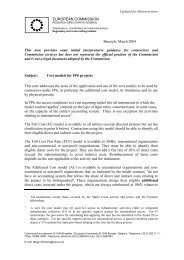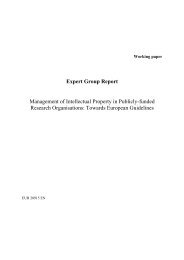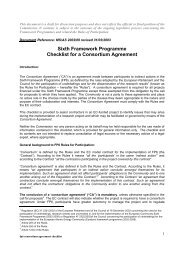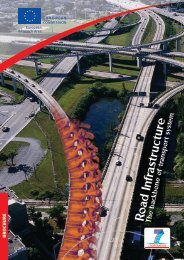Guide to Financial Issues relating to FP7 Indirect Actions - KoWi
Guide to Financial Issues relating to FP7 Indirect Actions - KoWi
Guide to Financial Issues relating to FP7 Indirect Actions - KoWi
Create successful ePaper yourself
Turn your PDF publications into a flip-book with our unique Google optimized e-Paper software.
• It has a formal external recognition, sometimes in the framework of a legal structure<br />
(for example, the relationship between an association and its members), sometimes in<br />
the absence of legal personality, through the sharing of common infrastructures and<br />
resources (joint labora<strong>to</strong>ry), separate from those of the legal entities composing them,<br />
or common ownership (affiliates, holding companies).<br />
"Ad hoc" collaboration agreements between legal entities <strong>to</strong> carry out work in the project are<br />
therefore not covered by this clause; in these cases both legal entities should be beneficiaries<br />
(with the limited exception of subcontracting in the cases where the rules allow it, as<br />
mentioned above).<br />
Cases specifically covered by the Special clause 10:<br />
• Joint Research Units (JRU): these are research labora<strong>to</strong>ries/infrastructures created<br />
and owned by two or more different legal entities in order <strong>to</strong> carry out research. They<br />
do not have a legal personality different from that of its members, but form a single<br />
research unit where staff and resources from the different members are put <strong>to</strong>gether <strong>to</strong><br />
the benefit of all. Though lacking legal personality, they exist physically, with<br />
premises, equipment, and resources individual <strong>to</strong> them and distinct from "owner"<br />
entities. A member of the JRU is the beneficiary and any other member of the JRU<br />
contributing <strong>to</strong> the project and who is not a beneficiary of the GA has <strong>to</strong> be identified<br />
in the clause. The JRU has <strong>to</strong> meet all the following conditions:<br />
<br />
<br />
<br />
scientific and economic unity<br />
last a certain length of time<br />
recognised by a public authority.<br />
It is necessary that the JRU itself is recognised by a public authority, i.e. an entity<br />
identified as such under the relevant national law. The beneficiary concerned shall<br />
provide <strong>to</strong> the Commission during the negotiation, a copy of the resolution, law,<br />
decree, decision, attesting the relationship between the beneficiary and the third<br />
party(ies), or a copy of the document establishing the "joint research unit", or any<br />
alternative document proving that research facilities are put in a common structure,<br />
and correspond <strong>to</strong> the concept of scientific and economic unit.<br />
• European Economic Interest Grouping (EEIG): an EEIG is a legal entity created<br />
under the rules of Council Regulation (EEC) No 2137/85 of 25 July 1985, composed<br />
of at least two legal entities from different Member States. In this case the EEIG is the<br />
beneficiary and its composing legal entities may be members included in the Special<br />
clause 10. The contrary (i.e. composing legal entity as beneficiary and EEIG as<br />
member in the clause) is not possible.<br />
• Affiliates: an affiliated entity means any legal entity that is under the direct or indirect<br />
control of the beneficiary, or under the same direct or indirect control as the<br />
beneficiary. Therefore it covers not only the case of parent companies or holdings and<br />
their affiliates and vice-versa, but also the case of affiliates between themselves.<br />
However, the entity performing most of the work should be the one appearing as<br />
beneficiary, and the others as the members detailed in the clause.<br />
• Groupings: The clause is used here either for associations, federations, or other legal<br />
entities composed of members (in this case, the Grouping is the beneficiary and the<br />
members contributing <strong>to</strong> the project should be listed). In the case of groupings without<br />
legal personality they will be treated as JRU if they meet the conditions mentioned<br />
52


